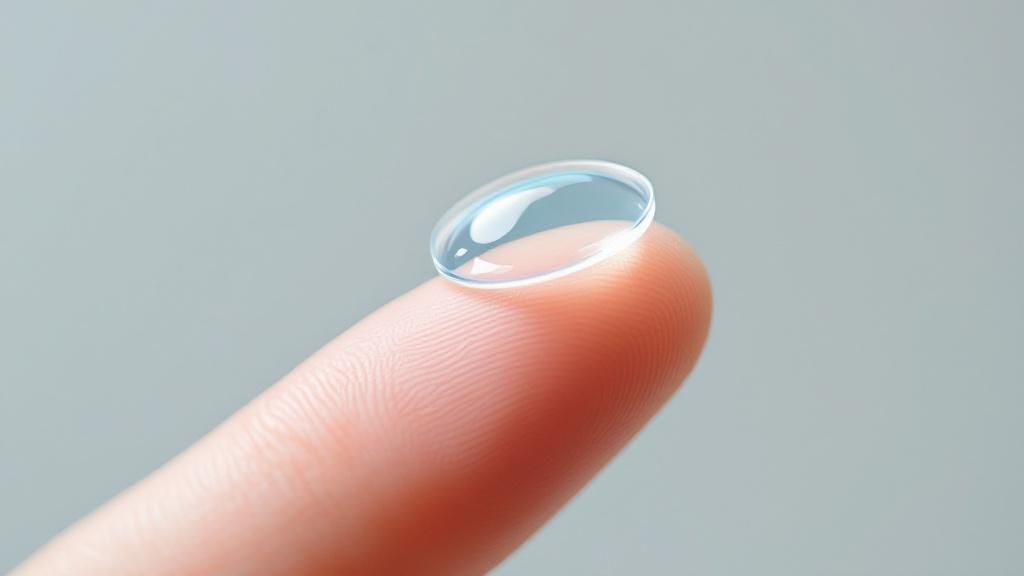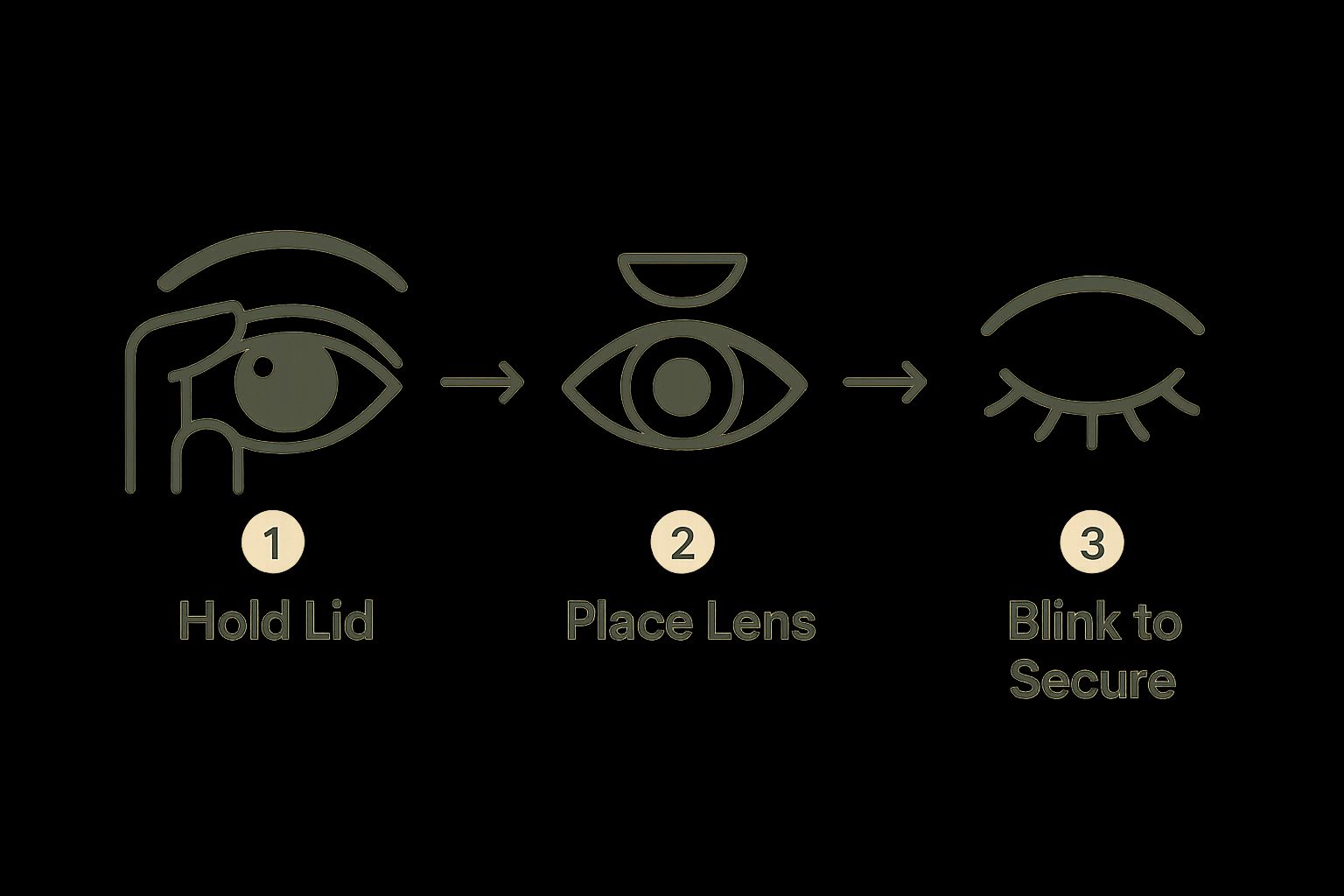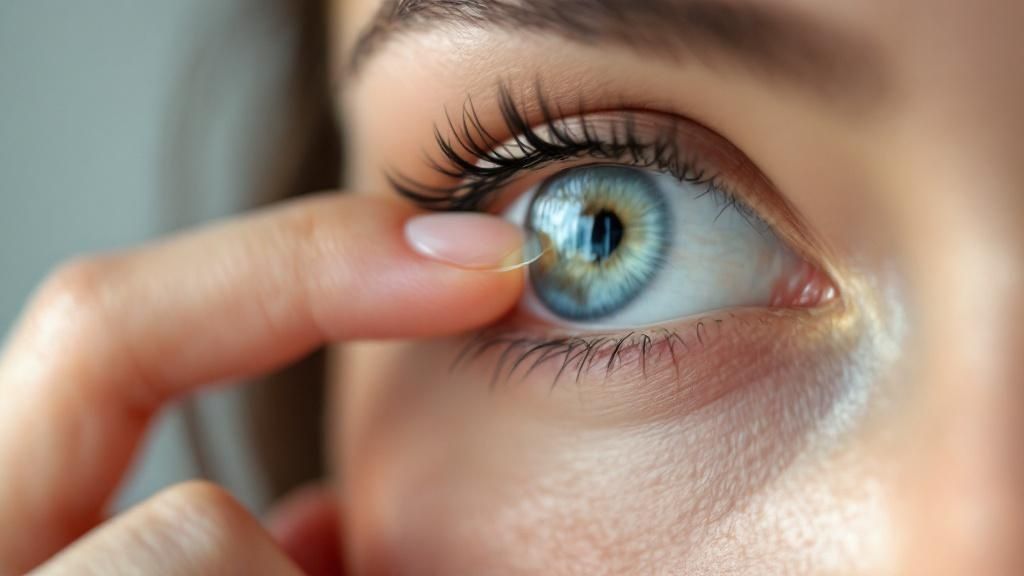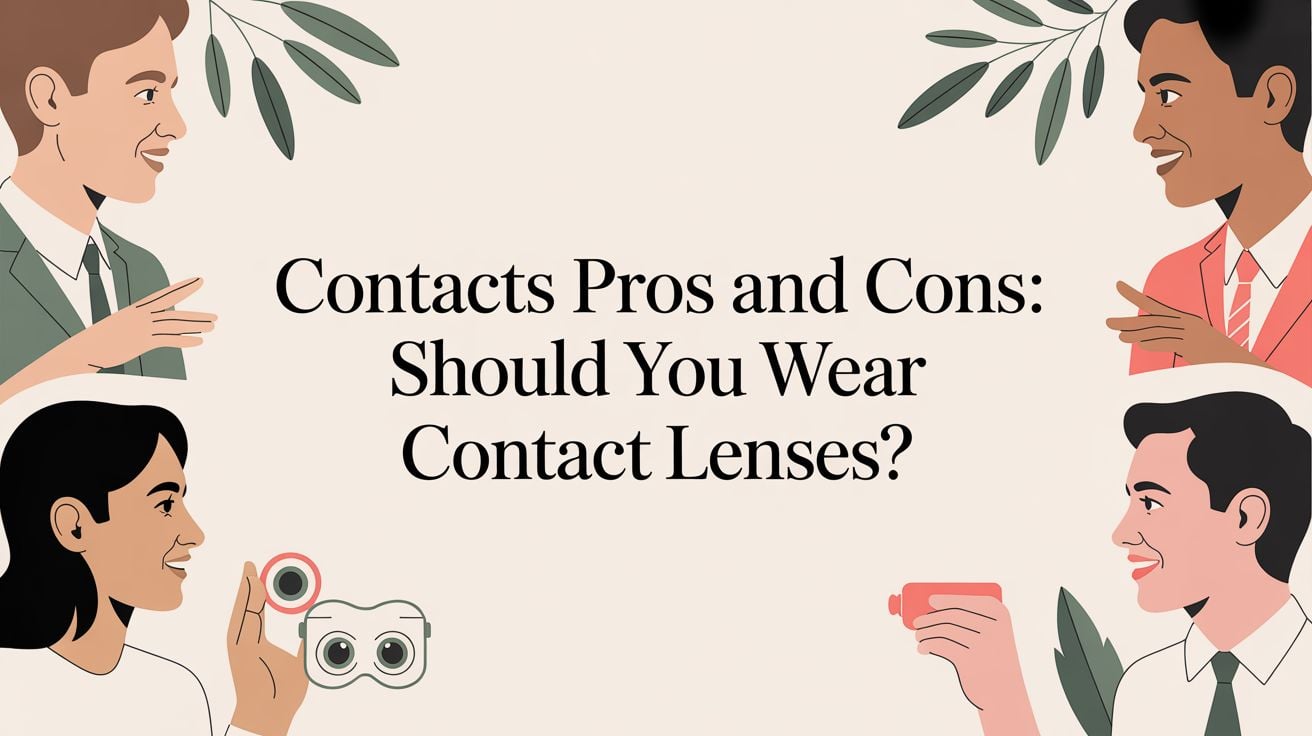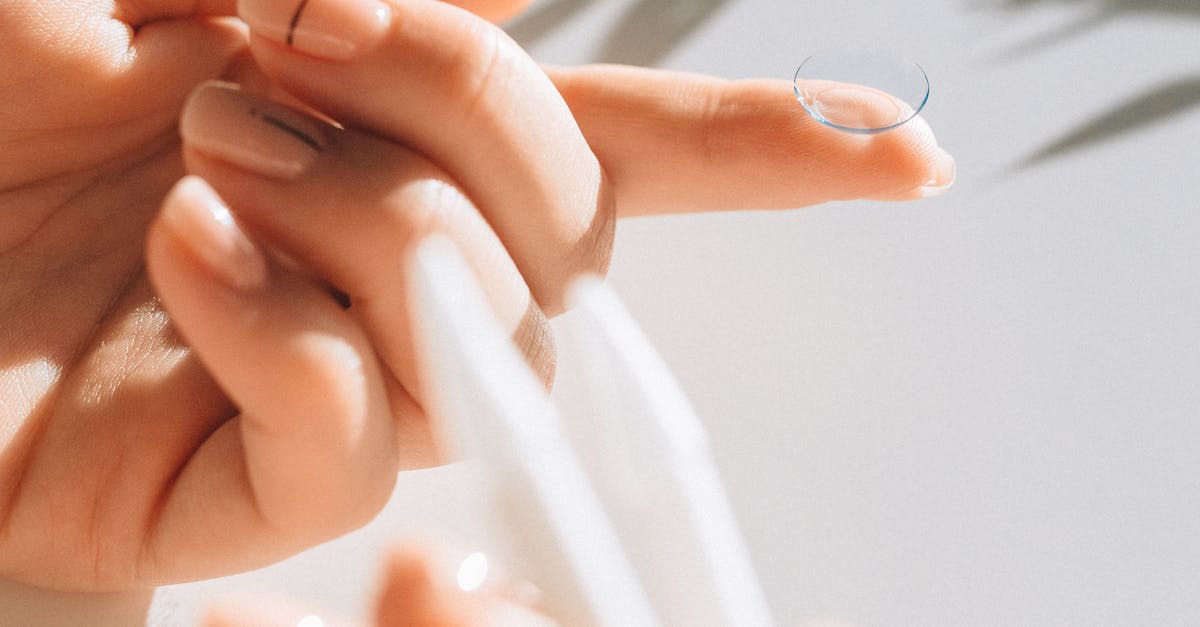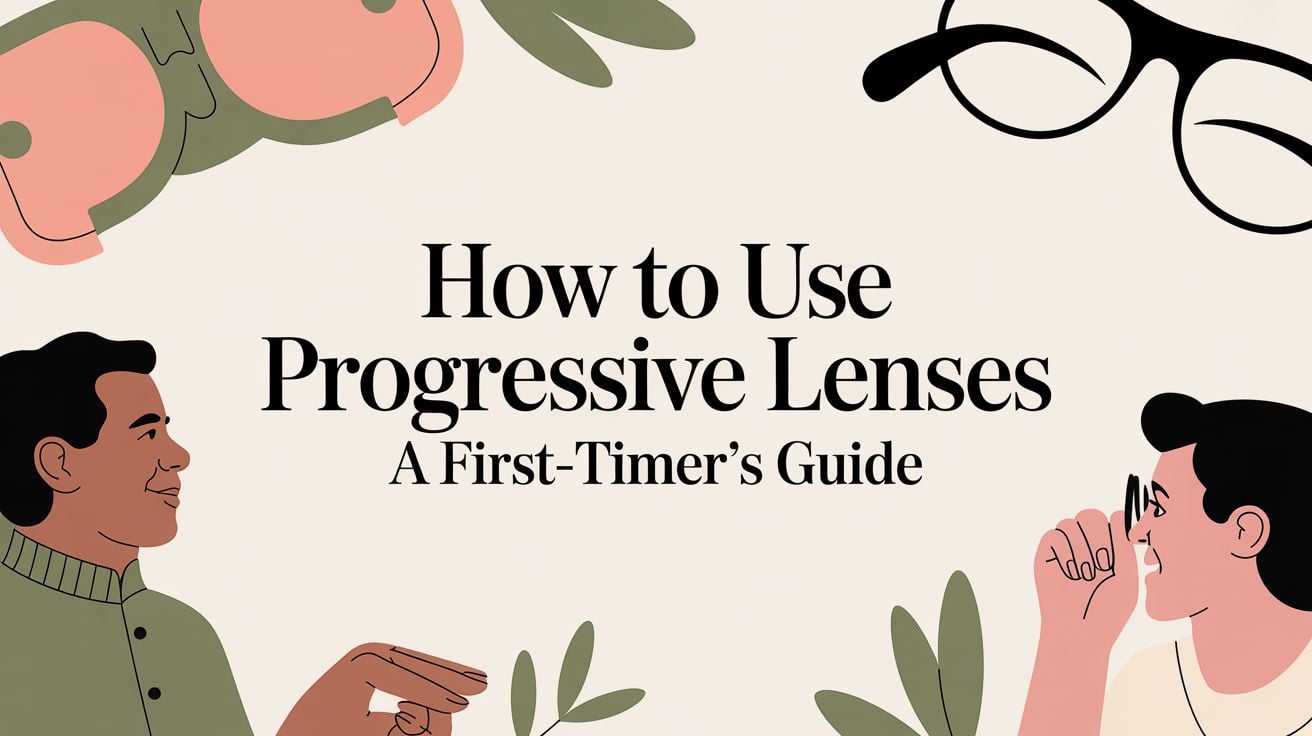Learning how to put in contact lenses for the first time can feel a little strange, but millions of people master it quickly and so can you. Soon enough, you'll be popping your contacts in without a second thought. For our new wearers here in Glendale Heights, the secret is simple: start with clean hands and a gentle touch.
Don't Worry, Your First Time Putting in Contacts Gets Easier
Learning how to put in contact lenses is a rite of passage for every new wearer. If you just drove home from our Glendale Heights boutique with your first pair, you’re probably feeling a mix of excitement and nerves. That’s completely normal. Here at iDoctor, we want you to feel just as confident at home as you did during your fitting with the best optometrist in Glendale Heights.
Think of this guide as your personal coaching session. We'll walk through the entire process together, from getting your hands clean to gently placing the lens on your eye. Mastering this isn't just about convenience; it's a crucial part of keeping your eyes healthy for the long haul.
Why Technique is Everything
A clean, gentle approach is non-negotiable for comfortable contact lens wear. It’s a bigger deal than you might think, especially with the contact lens market now valued at around USD 14.18 billion. With daily disposables accounting for almost 48.3% of those sales, safe handling is more important than ever. Getting this right from day one significantly drops your risk of irritation or, worse, an infection. You can discover more insights about the growing contact lens market and see why user safety is a top priority.
Our doctors always tell new wearers: The most important part of putting in your contacts isn't the insertion itself—it's the prep work. A few extra seconds of hygiene can save you from hours of discomfort.
Before you even touch a blister pack, setting up a clean routine is your key to success. This simple habit protects your eyes and helps you sidestep the common frustrations many new wearers face.
Whether you're a student at Glenbard West High School or working near the Glendale Lakes Business Park, this will soon become second nature. Now, let’s get into that all-important prep work.
Setting Up Your Space for a Perfect Insertion
Think of putting in your contacts like a mini-ritual. Rushing through it in a dimly lit, cluttered bathroom is a surefire way to get frustrated, drop a lens, or worse, irritate your eye. Before you even open the lens case, take a minute to set the stage.
Find a clean, flat surface in front of a mirror with plenty of light. The bathroom counter is usually the go-to spot for a reason. Having a good light source is key—it helps you see exactly what you’re doing, which makes a world of difference when you're starting out.
The Foundation of Cleanliness
Here’s the golden rule, the one step you can never, ever skip: wash your hands. Use a simple, non-oily soap and warm water, and be thorough. Then, dry your hands completely with a lint-free towel. This isn't just a suggestion; it's essential.
Why all the fuss about clean, dry hands?
- Residue: Lotions, perfumes, or leftover soap on your fingers can transfer to your lens, and that leads to instant stinging and cloudy vision.
- Debris: Microscopic lint fibers love to cling to wet fingers and will get trapped under your lens. It feels exactly like having a rogue eyelash stuck in your eye all day.
- Oils: Your skin's natural oils can smudge the lens surface, making your vision blurry from the get-go.
This is the first habit we instill in every patient during a professional professional contact lens fitting in Glendale Heights. It's the foundation for comfortable, problem-free wear. Of course, starting with the right product helps, too. If you're curious, you can explore our guide on the top comfortable contact lenses for all-day wear to see what options might work best for you.
At iDoctor, we always tell new wearers that what you do before touching the lens is just as important as the insertion technique. A clean space and pristine hands prevent most common issues right out of the gate.
Once your hands are perfectly clean and dry, it’s a good idea to lay a fresh towel down on the counter. It creates a soft, clean landing pad in case you accidentally drop a lens. Now you're ready to carefully open your contact lens blister pack or storage case, knowing you’ve set yourself up for success.
A Practical Method for Inserting Your Contact Lenses
Alright, this is the moment of truth. You’ve got your clean hands and your lens is ready to go. Let’s walk through how to pop that contact in for the first time without all the fumbling.
First things first, gently place the lens on the tip of your index finger. Now, take a good look at it. You want to see a perfect little bowl shape, with the edges pointing straight up. If it looks more like a saucer with the edges flaring out, it’s inside-out. No big deal—just flip it over with your clean fingers. Getting this right from the start saves you from a world of irritation.
The Two-Handed Technique: Your Best Friend for No-Blink Insertion
Here's a trick that makes a huge difference. Use the middle finger of the same hand holding the lens to pull your lower eyelid down. Then, take your other hand, reach over the top of your head, and use those fingers to pull your upper eyelid and lashes up against your brow bone.
This two-handed approach is the secret to overriding that powerful blink reflex. It gives you a wide-open, clear target.
Look straight into the mirror—or even slightly upward—and bring the lens calmly and steadily toward your eye. Let it gently touch the colored part (your iris).
The key is not to poke your eye! The lens is designed to glide right onto the moist surface of your cornea. A light touch is all it takes for it to adhere.
Once the lens is on, slowly let go of your eyelids, starting with the bottom one. Blink a couple of times naturally. You should feel the lens settle into place, and your vision will sharpen up almost immediately. It’s a pretty cool feeling, and I promise it gets easier and faster with practice.
This whole process is captured nicely in the image below.
As you can see, it really boils down to those three core actions: holding your lids open, placing the lens, and then blinking to get it centered.
Why Nailing This Down Is So Important
Let's be real: this will feel strange and clumsy at first. Everyone goes through it. But getting the technique down is more than just a convenience—it's about keeping your eyes healthy. In fact, research shows that around 15-20% of contact lens wearers experience discomfort that can be traced back to poor handling habits.
Learning to insert your lenses properly helps you steer clear of common problems like minor scratches on your cornea or infections. It’s the foundation of a good contact lens experience, and it's something we emphasize with every patient who visits our Glendale Heights boutique.
Having Trouble? Let's Work Through Common Insertion Problems
It’s completely normal to hit a few snags when you’re learning to put in contacts. Honestly, everyone fumbles a bit at the start, so don’t get discouraged if it takes a few tries (or ten!). Let's walk through some of the most common hiccups and how to fix them.
A classic issue is the lens that just won't leave your finger. If it’s sliding around or falling off before you even get close to your eye, it’s probably a bit too wet. A quick, gentle shake is usually all it takes to flick off that excess solution. Then, give it another go.
What To Do About Discomfort And Fit Issues
What if the lens folds or crumples the second it touches your eye? This almost always happens because of an involuntary blink. The trick is to get a better grip and open your eyelids wider than you think you need to. Really concentrate on using your non-dominant hand to hold that upper lid firmly against your brow bone—it makes a world of difference.
If you get the lens in but it immediately feels like there’s something stuck in your eye, take it out right away. That stinging or gritty feeling is a red flag. It usually points to one of three things:
- The lens is inside-out.
- There's a tiny tear or chip along the edge.
- A piece of dust or an eyelash is trapped underneath.
Carefully remove the lens, give it a good rinse with fresh multi-purpose solution, and inspect it closely in good light. If it looks fine, you can try again. But if the discomfort is still there, don't force it.
Never push through persistent pain or redness. It's your eye's way of telling you something is seriously wrong. Take the lens out, switch to your glasses, and give your eyes a break.
If you’re constantly struggling, it might not be your technique. Persistent problems often signal a poor fit. A lens that doesn’t match your eye’s unique curvature will cause chronic irritation and move around too much. This is exactly why a detailed eye exams in Glendale Heights is so crucial. We make sure the lens is perfectly suited to your eye shape for safe, comfortable wear.
To help you troubleshoot on the fly, here’s a quick guide to some of the issues you might face.
Common Contact Lens Insertion Problems and Solutions
| Problem | Possible Cause | Solution |
|---|---|---|
| Lens falls off your finger | Too much solution on the lens or finger. | Gently shake the lens to remove excess solution. Make sure your fingertip is dry. |
| Lens folds on the eye | You blinked during insertion. | Hold your upper and lower eyelids firmly. Try to look straight ahead or slightly up, not at the lens itself. |
| Stinging or gritty feeling | Debris, an inside-out lens, or a torn lens. | Remove, rinse with fresh solution, and inspect the lens. Re-insert if it looks okay. |
| Lens won't center on the eye | Lens is not fully on the cornea; air bubbles. | Close your eye gently and massage the lid, or look in the opposite direction of the lens to help it settle. |
| Blurry vision after insertion | Lens is inside-out, dirty, or the wrong prescription. | Remove and check the lens orientation (the "taco test"). Clean it if necessary. If it persists, consult your optometrist. |
Remember, practice and proper hygiene are your best friends. For more essential tips on keeping your eyes healthy, check out our guide on how to prevent common contact lens infections.
Your Daily Lens Care Routine: What Happens Next
Congratulations, the lens is in! Getting comfortable putting in your contacts is a huge milestone. But what you do after you take them out is just as crucial for keeping your eyes feeling great and free from problems. A consistent daily care routine is non-negotiable for eye health.
If you're using daily disposables, your end-of-day routine is refreshingly simple. After a long day, perhaps enjoying an event at Camera Park, just wash your hands thoroughly, gently take out the lenses, and toss them. No cleaning, no cases, no fuss. You get a brand-new, sterile pair every single morning.
Taking Care of Reusable Lenses
For those who wear bi-weekly or monthly lenses, a few extra steps are essential. Your lenses collect a surprising amount of buildup throughout the day—think proteins from your tears, dust, and bacteria. Cleaning them properly is the only way to get rid of it.
Once you’ve removed a lens, cup it in your clean palm. Squeeze a few drops of a quality multi-purpose solution onto it. Then, using the pad of your finger, gently rub the lens back and forth for 15-20 seconds. This gentle friction is what really lifts away the grime that you can't even see.
Key Takeaway: Never use tap water to rinse your lenses or case. Ever. Water harbors microorganisms that can lead to severe eye infections. And don't just "top off" the old solution in your case—it's lost its disinfecting power. Always dump the old stuff and use fresh solution, every single time.
After rubbing, place the clean lens into its storage case and completely cover it with fresh solution. It's also smart to give your eyes a break now and then. Having a stylish pair of backup glasses, maybe from our Cartier or Ray-Ban collection, is the perfect way to let your eyes rest. For a complete guide, check out our post on the best way to clean contacts to ensure you're doing everything right.
Here at iDoctor, we walk every one of our Glendale Heights patients through these care steps during their fitting, making sure they leave with the skill and confidence to keep their eyes healthy.
Your Local Glendale Heights Contact Lens FAQ
Starting your journey with contact lenses is exciting, but it's natural to have a few questions. As your local eye doctor in Glendale Heights, we want to provide clear, helpful answers so you can feel confident every step of the way.
Do I need a special appointment to get contact lenses in Glendale Heights?
Yes, a contact lens fitting is different from a regular eye exam. Here at iDoctor, our detailed eye exams in Glendale Heights can include a specialized fitting. During this 30-minute appointment, we use high-resolution imaging to measure your eye's unique shape and ensure the perfect lens fit. We also provide one-on-one training to make sure you're comfortable putting them in and taking them out.
What should I do if my lens feels uncomfortable after putting it in?
First, take it out immediately. Rinse it with fresh solution and check for three things: 1) Is it inside-out (use the "taco test")? 2) Is there a tiny tear on the edge? 3) Is there any debris like an eyelash stuck to it? If it looks fine, you can try again. If the irritation continues, wear your glasses and give us a call. Never force it, as it could be a sign of a poor fit or other issue.
Does iDoctor carry designer eyeglasses for when I'm not wearing contacts?
Absolutely! We believe everyone needs a great pair of glasses. We offer a curated collection of designer eyeglasses in Glendale Heights, including luxury brands like Gucci, Tom Ford, and Cartier, as well as affordable favorites like Ray-Ban and Kate Spade. Giving your eyes a break with a stylish pair of glasses is a healthy habit we highly recommend.
Which is better for a new wearer: daily or monthly contacts?
This often depends on your lifestyle. Daily disposables are very popular because they are low-maintenance and hygienic—no cleaning required. Monthly lenses can be more cost-effective but require a strict daily cleaning routine. We can discuss the pros and cons for your specific needs during your fitting. You can also read more in our guide to daily disposable vs. monthly contact lenses in Glendale Heights.
Ready to experience the freedom of crystal-clear vision with contact lenses in Glendale Heights? At iDoctor, we combine expert care with a premier selection of lenses to protect your eye health and ensure all-day comfort. Schedule your appointment at our Glendale Heights boutique today.


